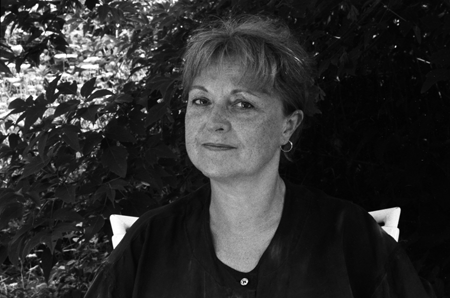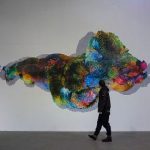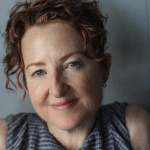Meet a NYFA Artist: Michelle Stuart
NYFA speaks with Michelle Stuart (NYFA Fellow in Painting, 1987) on what informs her artistic process, and her traveling solo exhibit, Drawn From Nature, which is at the Parrish Art Museum in Water Mill, New York through October 27th.
NYFA: There has always been a fusion of art and nature within your work. Can you talk about where the inspiration for this came from and how you began creating work in this medium? Are there any challenges that arise in using these natural materials?
MS: One is influenced by both art and nature and probably DNA- we have so much to learn about that field of inquiry. It’s the child in the adult that chooses the connection that the imagination takes. The subject of a work is always a question that the artist or the work itself is seeking to answer, there must be an underlying question to be posed, it doesn’t have to be answered, but art challanges mysteries and tries to answer and one simply leads to another
NYFA: There’s a tremendous variation in the size of your work, from large, monumental land art pieces to smaller, more intimate photos and drawings. Can you explain the challenges or benefits in creating art that varies so much in size and space?
MS: If the subject of a work demands or requires it to be large in scale to be communicated in the way that you want then it needs to be large because it cannot be expressed in any other way. However, meaning can change with size. If it is big just for attention’s sake knowledgeable viewers know it and don’t engage. The hardest mystery to communicate is grandeur on a small scale and Joseph Cornell manages to do it.

Scanning Sequence, 1969-70
Graphite rubbing over earth on paper, painted pine containers
Photo Credit: O. Nelson, The Metropolitan Museum of Art
NYFA: Your work Scanning Sequence is currently on view in the group show, Land Marks, at the Metropolitan Museum of Art. Can you talk about this piece and the idea behind the exhibition?
MS: When the Metropolitan Museum purchased Scanning Sequence, the question of motivation arose. I did that piece forty-three years ago and I do recall that sequential movement, evolutionary change, time, and the imprint of change, shadows, light, movement were in my mind, but motivation is mercurial, seismic shifts interested me (I am originally from California). When I look at the piece today I wonder if perhaps Muybridge played a part. I studied both film and photography in the 1960’s and one is always secretly engaged on some level with other passions. One of mine was and still is (meaning in) photographic images.

#9 Zena scroll, 1973
Graphite rubbing over earth on muslin-mounted rag paper
144 x 60"
Photo Credit: Bevan Davies, Leslie Tonkonow Artworks + Projects
NYFA: Having worked across a broad spectrum of artistic disciplines, including drawing, photography, sculpture, installation and even bookmaking, do you find that your different creative processes for each discipline ever inform one and other?
MS: Absolutely, especially sculpture, drawing and photography which are deeply related, something that Brancusi realized and demonstrated. When I was a young artist everything was catagorized, you were a painter, or a sculptor. A curator from a major New York museum on a studio visit said to me of the box pieces in the early 1970’s “I don’t know what it is—drawing, painting or sculpture.” Painting had to have color, sculpture was on the floor and since drawing wasn’t important then she dismissed it. Everything informs. I can remember Borges entered my work, then Bachelard, then Sebald.
NYFA: As of recent, your work has predominantly focused on photography. Can you share the story behind this shift?
MS: My work has always used photography. There is no shift. It has been used in my work almost from the beginning. It is simply that the reason for its use has changed. Early I used it much like the photographers of the early western United States, the expeditonary recorders like O’Sullivan. I was documenting, observing and then using it as sequential memory story boards that inform. The series pieces were named Codex: Serpent Mound or Codex: Canyon de Chelley and they were photographs taken as I walked around the different sites but were always shown with earth from the site. One could say that they are related to pre-Columbian codices in graphic images. Now I use it in a different way, a non linear open narrative form. I say open because it is not closed, the viewer provides his or her ending to the reading. It appears to be sequential in the presentation, but it is non- sequential in the reading. Related to a movie roll if you like.

Stone Alignments/Solstice Cairns, 1979
Detail.
Permanent land work, Rowena Plateau, Oregon, 3200 boulders of varying sizes,
Overall: 1000 x 800 feet; cairns: approx. 5 feet high; circle: 100 feet.
Photo Credit: Michelle Stuart, Leslie Tonkonow Artworks + Projects
NYFA: You have a traveling solo exhibition, Drawn from Nature, opening at the Parrish Art Museum in Water Mill, NY on July 21st. Can you tell us about this exhibit and the work included in it?
MS: Professor Anna Lovatt of the University of Manchester, UK curated this exhibition. It initially was to be a drawing exhibit but morphed into a survey of works on or using paper including some sculptural objects and photographic works. It starts in 1968 and follows the trajectory of the work until 2010. There are about sixty works in the exhibit.
Lovatt’s insightful essay in the catalogue/book that accompanies the exhibit, along with another essay by Nancy Princenthal and an interview by Julie Joyce of the Santa Barbara Art Museum, (the last venue )and a multitude of images should answer your question. The book is called Michelle Stuart: Drawn from Nature and is published by Hatje Cantz Verlag and is available through DAP.
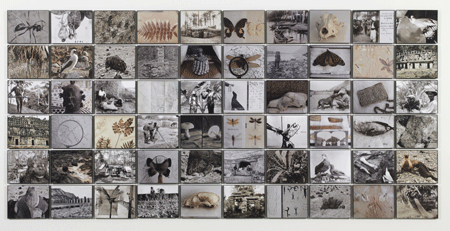
Earth Memory: Seekers, 2011
Archival pigment prints
60 units: 51 ¾ x 106 ¾" overall; 8 x 10" each
Photo Credit: Jeffrey Sturges, Leslie Tonkonow Artworks + Projects
NYFA: As a successful working artist for over 40 years, do you approach your work differently now in any way then you did at the beginning of your artistic life?
MS: Not really, I still am in the studio every day asking myself different questions and trying to answer them. Making art is an emotional and intellectual exploration of one’s interior world isn’t it? I see it as relating to poetry more than anything else.
NYFA: Do you have any advice that you’d like to leave for emerging artists?
MS: The climate of art has changed so much that I should be asking them questions not the other way around, but I would say believe in yourself and do not give up.
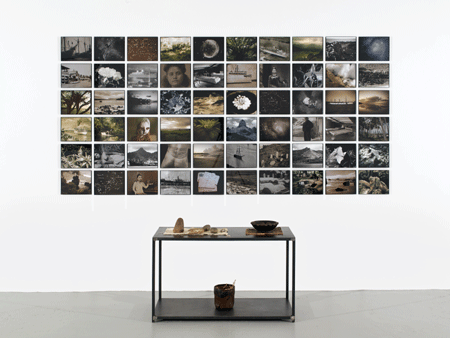
Ring of Fire, 2008-2010
Wall piece: digitized analog photographs, archival paper;
Metal table: stones, Samoan wood container, seeds, Tonga tapa cloth, cotton cloth, Philippine basket
Wall: 58 x 119"
Table: 28 1⁄4 x 40 x 18 1⁄4"
Photo Credit: Jeffrey Sturges, Leslie Tonkonow Artworks + Projects
—Interview by James Ciano
For more information on Michelle Stuart, please visit her website.
To learn more about her upcoming exhibit, Drawn From Nature, click here.
Visit publisher Hatje Cantz Verlag’s website to purchase a copy of the exhibit’s accompanying book & catalog.

